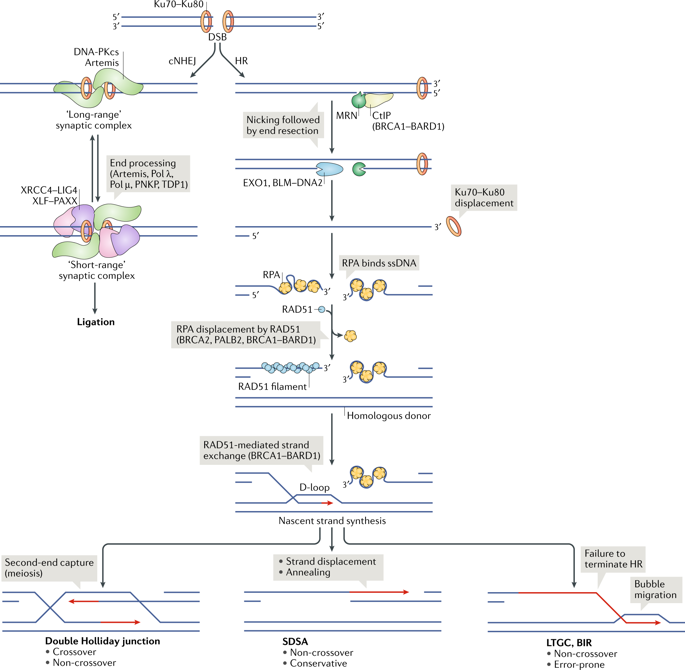当前位置:
X-MOL 学术
›
Nat. Rev. Mol. Cell Biol.
›
论文详情
Our official English website, www.x-mol.net, welcomes your
feedback! (Note: you will need to create a separate account there.)
DNA double-strand break repair-pathway choice in somatic mammalian cells.
Nature Reviews Molecular Cell Biology ( IF 81.3 ) Pub Date : 2019-07-01 , DOI: 10.1038/s41580-019-0152-0 Ralph Scully 1 , Arvind Panday 1 , Rajula Elango 1 , Nicholas A Willis 1
Nature Reviews Molecular Cell Biology ( IF 81.3 ) Pub Date : 2019-07-01 , DOI: 10.1038/s41580-019-0152-0 Ralph Scully 1 , Arvind Panday 1 , Rajula Elango 1 , Nicholas A Willis 1
Affiliation

|
The major pathways of DNA double-strand break (DSB) repair are crucial for maintaining genomic stability. However, if deployed in an inappropriate cellular context, these same repair functions can mediate chromosome rearrangements that underlie various human diseases, ranging from developmental disorders to cancer. The two major mechanisms of DSB repair in mammalian cells are non-homologous end joining (NHEJ) and homologous recombination. In this Review, we consider DSB repair-pathway choice in somatic mammalian cells as a series of 'decision trees', and explore how defective pathway choice can lead to genomic instability. Stalled, collapsed or broken DNA replication forks present a distinctive challenge to the DSB repair system. Emerging evidence suggests that the 'rules' governing repair-pathway choice at stalled replication forks differ from those at replication-independent DSBs.
中文翻译:

哺乳动物体细胞中 DNA 双链断裂修复途径的选择。
DNA 双链断裂 (DSB) 修复的主要途径对于维持基因组稳定性至关重要。然而,如果部署在不适当的细胞环境中,这些相同的修复功能可以介导染色体重排,这些重排是各种人类疾病的基础,从发育障碍到癌症。哺乳动物细胞中 DSB 修复的两种主要机制是非同源末端连接 (NHEJ) 和同源重组。在这篇综述中,我们将哺乳动物体细胞中的 DSB 修复途径选择视为一系列“决策树”,并探索有缺陷的途径选择如何导致基因组不稳定。停滞、塌陷或断裂的 DNA 复制叉对 DSB 修复系统提出了独特的挑战。新出现的证据表明,“规则”
更新日期:2019-11-18
中文翻译:

哺乳动物体细胞中 DNA 双链断裂修复途径的选择。
DNA 双链断裂 (DSB) 修复的主要途径对于维持基因组稳定性至关重要。然而,如果部署在不适当的细胞环境中,这些相同的修复功能可以介导染色体重排,这些重排是各种人类疾病的基础,从发育障碍到癌症。哺乳动物细胞中 DSB 修复的两种主要机制是非同源末端连接 (NHEJ) 和同源重组。在这篇综述中,我们将哺乳动物体细胞中的 DSB 修复途径选择视为一系列“决策树”,并探索有缺陷的途径选择如何导致基因组不稳定。停滞、塌陷或断裂的 DNA 复制叉对 DSB 修复系统提出了独特的挑战。新出现的证据表明,“规则”











































 京公网安备 11010802027423号
京公网安备 11010802027423号